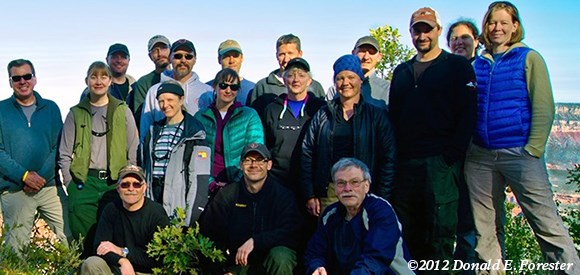Last updated: January 17, 2017
Article
Wildfire at Grand Canyon National Park: Visiting Our Past to Build Our Future

Photo by Donald Forester at Fire Point, North Rim, Grand Canyon National Park.
“The goal of the field trip was to allow past fire staff an opportunity to see firsthand all the work they accomplished over the past 30 years, and show them that the current fire staff has and will continue to build off that work to maintain wildfires as a key ecological process component in our park forests.”—Chris Marks, deputy fire management officer
Current fire management staff at Grand Canyon National Park (GRCA) invited past GRCA fire management officers, ecologists, and prescribed fire specialists to the North Rim for a field trip to develop a vision for the future of the wildland fire program on the rim of Grand Canyon. In all, 16 past and present fire managers with a total of 152 years of GRCA fire experience attended the three-day field trip to discuss success stories, lessons learned, future climate changes, and fire effects.
While visiting the North Rim in fall 2012, the group toured past wildfire areas to assess postfire recovery. They also discussed future projects in those postfire areas to ensure the perpetuation of wildland fires for the future.
“The goal of the field trip was to allow past fire staff an opportunity to see firsthand all the work they accomplished over the past 30 years, and show them that the current fire staff has and will continue to build off that work to maintain wildfires as a key ecological process component in our park forests,” stated Deputy Fire Management Officer Chris Marks.
The group stopped at several areas with recent fire history, some areas of which had experienced two or more fires over the past 20 years. While at these areas, the group discussed the need to clearly define what success looks like through fire effects monitoring, understanding fire’s role in wilderness, improving relationships with our neighboring agencies, and cultivating and celebrating successes. While walking through unburned mixed conifer forests, the group talked about risk management. Managing fire in the mixed conifer forests presents challenges to park staff, because much of the forest is Mexican spotted owl critical habitat, lacks recent fire history, and has potential to burn with large areas of high severity, stand-replacement fire effects. Although every fire is different, the consensus among the group was that suppressing fires today increases future risk to firefighters and the public, and the perpetuation of mixed conifer forests.
“Suppressing today’s fires may lead to permanent forest type conversion when the next fire burns this area. Future fires on the North Rim may burn hotter, longer, and spread faster than we’ve ever experienced in the past,” said Marks.
Other discussions in the unburned areas of the North Rim included concerns about postfire recovery in the future with uncertain climate changes, protection of endangered species habitat, and improved communication with our neighboring land managers to manage fires across a landscape instead of within agency boundaries.
The field trip was a success. Current and future fire staff will now have opportunities to make informed decisions using successes and lessons learned from the participants’ 150-plus years of GRCA fire experience.
Contact: Christopher Marks, deputy fire management officer
E-mail: e-mail us
Phone: 928-638-7820
